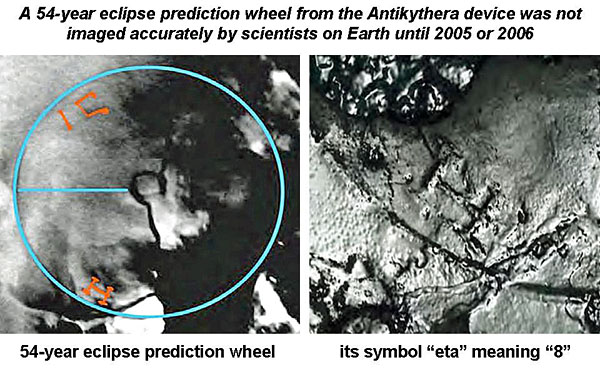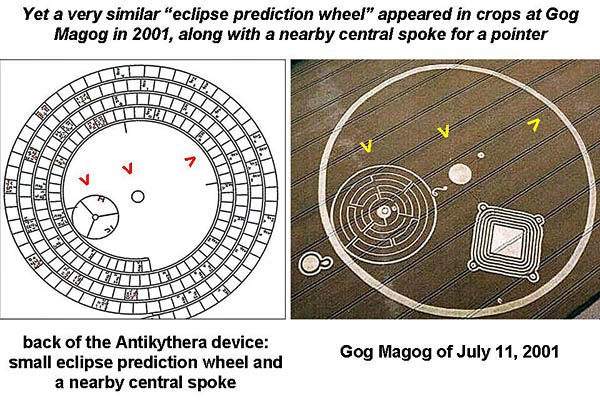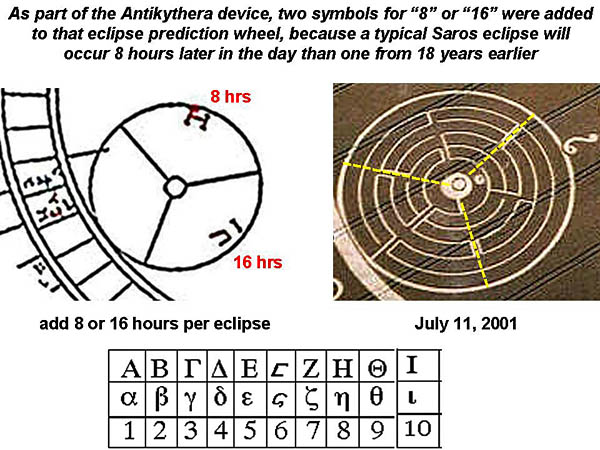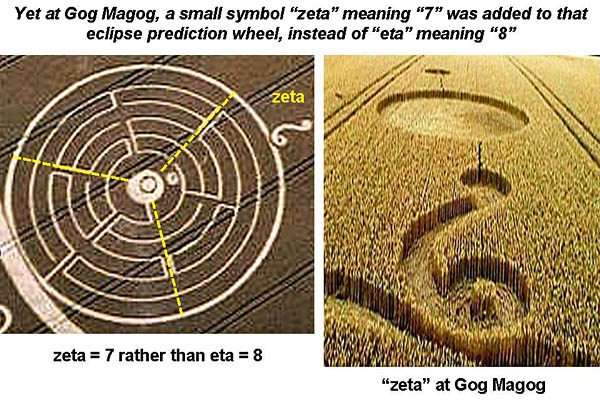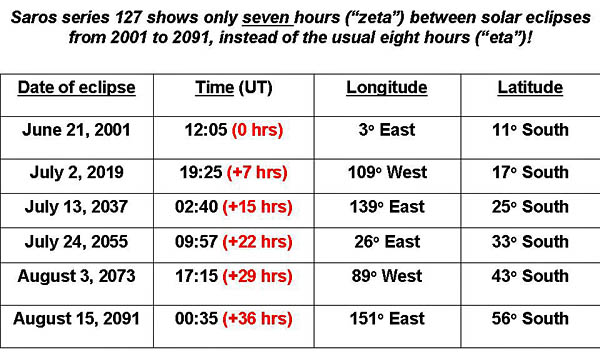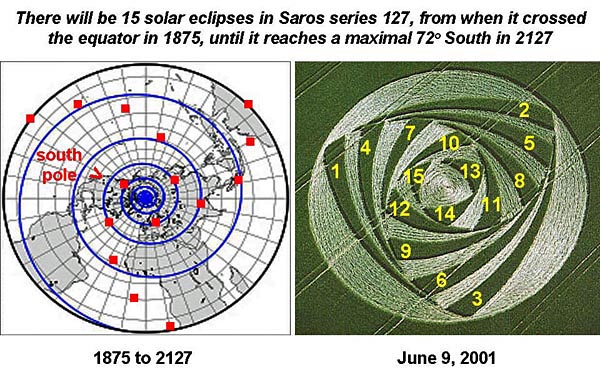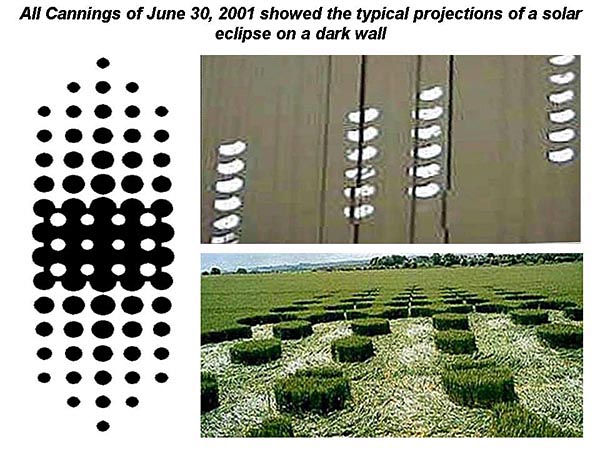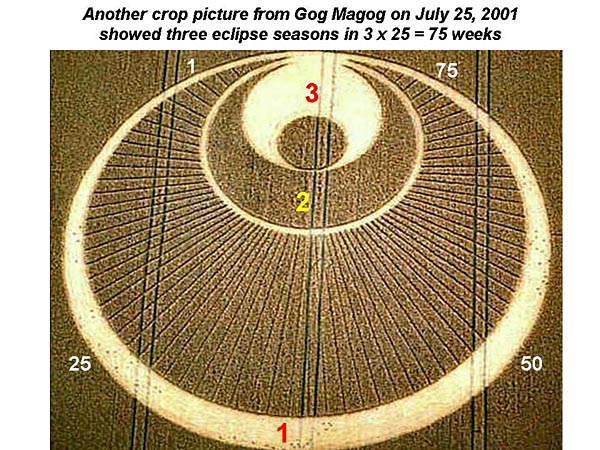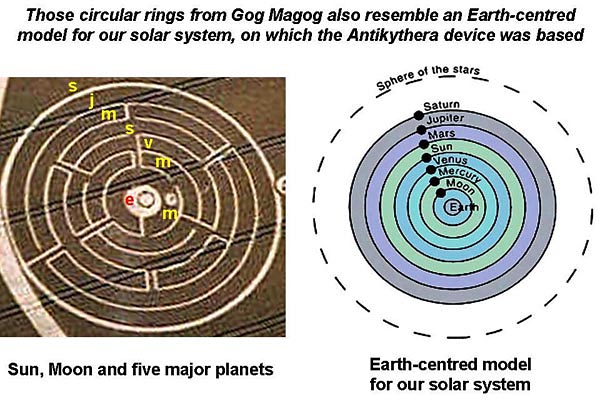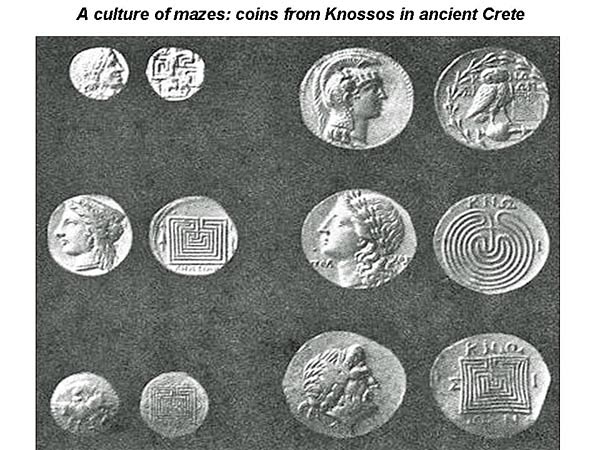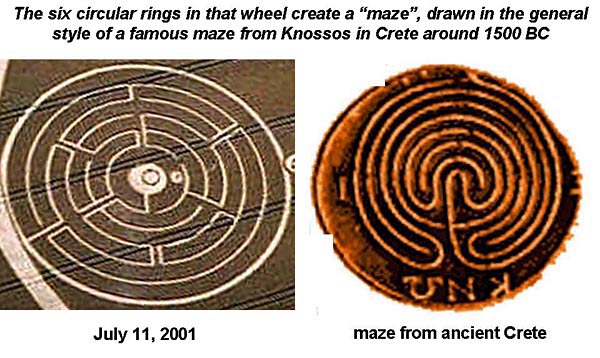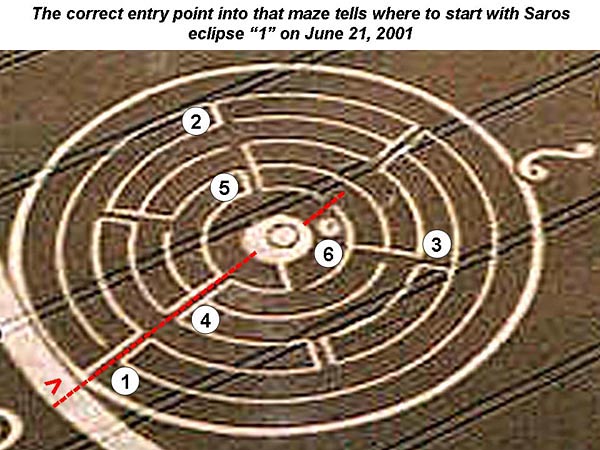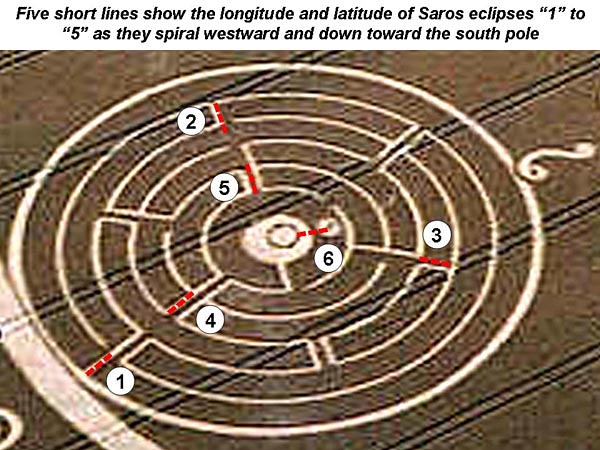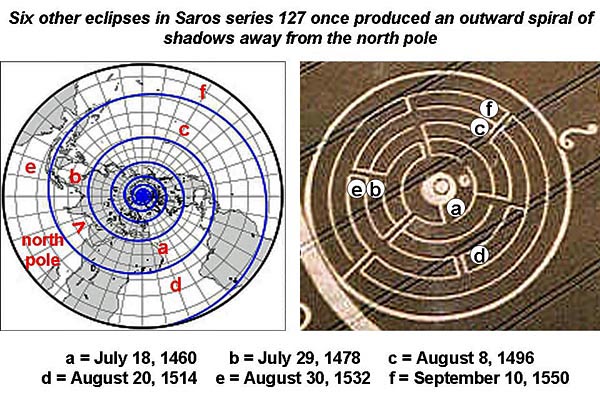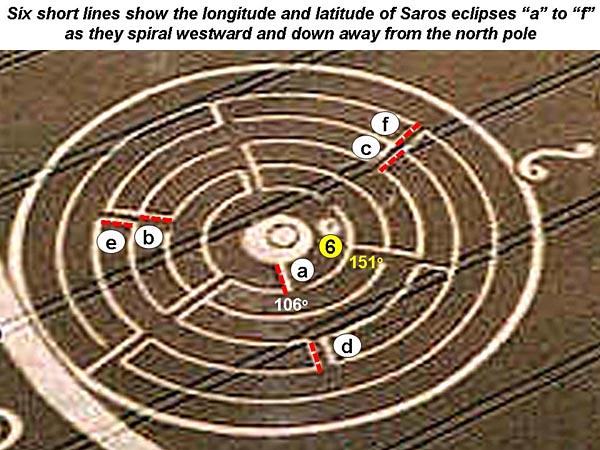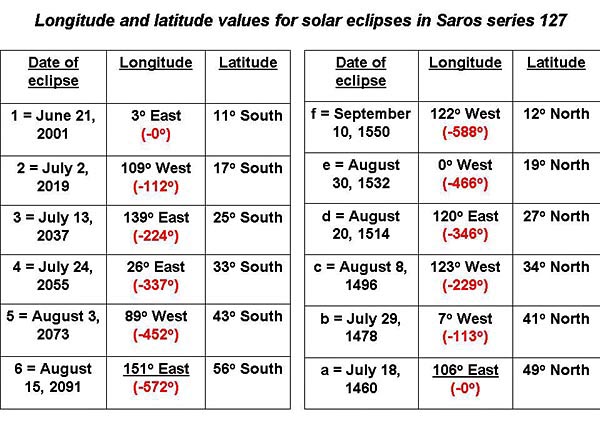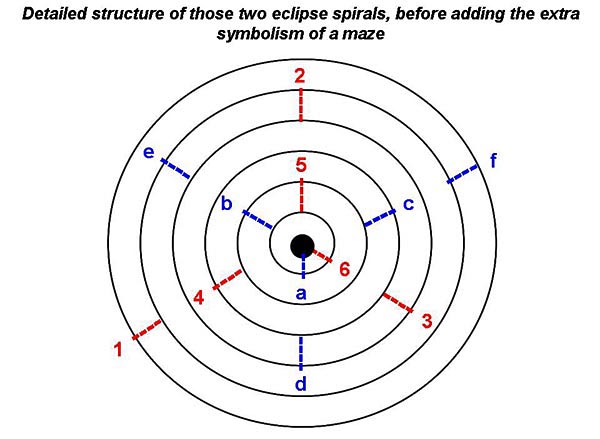|
Part of the Antikythera device was shown in crops at Gog Magog in 2001, five years before it was imaged by scientists on Earth in 2005 or 2006: it’s all Greek to me! Part of an ancient astronomical computer known as the “Antikythera device” was shown in crops near Gog Magog Hills, just outside of Cambridge, in July of 2001 (see www.cropcircleconnector.com). The significance of that event was clearly its future-predictive nature. Thus, scientists on Earth did not find out similarly detailed information concerning the Antikythera device until five years later (see time2007u.html). To be more specific, a 54-year eclipse prediction wheel from the back of the Antikythera device was not imaged accurately by scientists on Earth until late 2005 or 2006 (see T. Freeth et al., Nature 454, 614-617, 2008):
Two small Greek letters along the outer rim of that wheel show the characters “eta” meaning “8”, or “iota-digamma” meaning “16”, for astronomical purposes as will be discussed below. Yet a very similar “eclipse prediction wheel” appeared mysteriously in crops at Gog Magog in 2001, along with a nearby central spoke for a pointer:
That small triangular wheel (indicated by red or yellow arrows) was used to predict eclipses over a long calendar period of 54 years and 34 days, while the large spiral that surrounds it (shown on the left above) was used to predict eclipses over a relatively short period of 18 years, 11 days and 8 hours. The long period of 54 years and 34 days is called an Exeligmos cycle, while the short period of 18 years, 11 days and 8 hours is called a Saros cycle (see www.antikythera-mechanism.gr or www.sciam.com/article.cfm?id=antikythera-mechanism-eclipse-olympics or antikythera). Many interesting details of that Gog Magog crop picture were discussed in a previous article (see time2007u). Here we will discuss other important aspects of that remarkable crop picture, as well as other related crop pictures from the summer of 2001, and we will relate them to the general historical period during which that Antikythera device was made. Zeta versus eta, seven versus eight As part of the Antikythera device, two small symbols for “eta” meaning “8” or “iota-digamma” meaning “16” were added to that eclipse prediction wheel:
The reason was because any new eclipse belonging to the same Saros series will occur typically 8 hours later in the day than an eclipse from 18 years earlier, or 16 hours later in the day than an eclipse from 36 years earlier. Yet at Gog Magog in 2001, a small symbol “zeta” meaning “7” was added to that eclipse prediction wheel, instead of “eta” meaning “8”:
One other possible interpretation of that small Greek symbol might be "stigma" meaning "six”. Indeed, the crop picture told us about six eclipses! Yet given its precise location at the edge of the eclipse prediction wheel, a much more plausible interpretation would be "zeta" for "seven hours between eclipses”, instead of the usual “eta” for “eight hours between eclipses”. Why would those crop artists wish to substitute a new symbol “zeta” on the edge of their eclipse prediction wheel, when most Saros eclipses differ from one another by an average of eight hours over 18 years? The overall message of Gog Magog concerned six total solar eclipses, all belonging to Saros series 127. The first occurred on June 21, 2001, just three weeks before the crop picture appeared, while the sixth and last will occur on August 15, 2091 (see time2007u.html). Now if we look carefully at the predicted times for those eclipses, we find that all six of them will occur seven hours later in the day than a related eclipse from 18 years earlier:
It turns out that Saros eclipses are somewhat variable in terms of their daily times of appearance. They average eight hours per eclipse for the most part, but sometimes show differences of daily time as short as six hours, or as long as nine hours. So those crop artists showed us a symbol “zeta” on their eclipse prediction wheel, instead of “eta” as drawn on the Antikythera device, because they wished to tell us about eclipses from Saros series 127, and not just ordinary eclipses of any kind. A clever scientific joke: zeta for eta, seven for eight! Yet how many people on Earth today will be able to appreciate the humour expressed there? Several other crop pictures from 2001 also described eclipses In addition to Gog Magog of July 11, 2001, there were quite a few other crop pictures from the summer of 2001 that described eclipses. Berwick Bassett of June 9, 2001 showed a slightly different theme concerning the science of eclipses. Thus, there will be a total of 15 solar eclipses in Saros series 127, from when it crossed the equator going north to south in 1875, until it reaches a maximal 72o South in 2127:
Table 1. Fifteen solar eclipses will be required for Saros series 127 to cross the equator in 1875, then reach a maximal 72o South in 2127
All Cannings of June 30, 2001 showed the typical projections of a solar eclipse on a dark wall:
The Gog Magog “angel” of July 25, 2001 showed three eclipse symbols and 75 thin lines. Those thin lines imply a total of 75 weeks, or 25 weeks per eclipse:
Milk Hill of August 13, 2001 was called a “fractal” by many people, yet seems to show a series of six lunar months where our Moon spends 13 days above the horizon at midnight (see Stonehenge code). Six lunar months likewise equal one eclipse season or 25 weeks. Several crop pictures from the summer of 2008 showed a style similar to that of Gog Magog on July 25, 2001. For example, West Kennett Longbarrow of June 9, 2008 showed "48 weeks or 50 days" before/until the next lunar/solar eclipse. Furze Knoll of June 20, 2008 showed "25 weeks" in any eclipse season. Hillside Farm of July 20, 2008 showed "47, 48 or 50 weeks" between current eclipses (see 080808). Finally, six circular rings which subdivided the eclipse prediction wheel at Gog Magog (to tell us about six eclipses) also seem to resemble the Earth-centred solar system of Claudius Ptolemy, on which the Antikythera device was originally based:
A culture of mazes Why did those crop artists convert that small eclipse prediction wheel from the Antikythera device into an elaborate maze at Gog Magog in 2001? Probably to remind us of the historical context in which the Antikythera device was made! Thus, there was a famous maze at Knossos in ancient Crete around 1500 BC (see www.unmuseum.org/minot.htm). That maze became so famous, following the Greek conquest of Crete in 1250 BC, that it was inscribed on local coins:
The six circular rings from Gog Magog in 2001 also create a maze, which matches the general style of that Cretan maze long ago:
A single correct entry point into the crop maze tells where to start with Saros eclipse “1” on June 21, 2001:
Five short lines then show the latitude and longitude of Saros eclipses “1” to “5” as they spiral westward and down toward the south pole:
What about other lines not yet accounted for? Well, six other eclipses in Saros series 127 once produced an outward spiral of shadows away from the north pole:
Six short lines then show the longitude and latitude of Saros eclipses “a” to “f” as they spiral westward and down away from the north pole:
How accurately do those two sets of eclipses match one another? The final eclipse "6" from 2091 has a longitude of 151o East, while the first eclipse "a" from 1460 has a longitude of 106o East. The angular difference between them as 45o matches fairly well an angular difference of 60o between the innermost symbols from that maze:
Those two spirals of eclipses would have looked like the diagram shown below, before our crop artist friends added the extra symbolism of a maze:
Such observations seem to account satisfactorily for many aspects of the crop maze, but are certainly not meant to be the last word on this difficult subject. If any students of the Antikythera device, or of maze mathematics, are able to find further meaning in that Gog Magog maze, we would certainly encourage them to make it known. Predicting the future: yes, they can really do it! Prior to this analysis, there were three clear-cut examples from the years 1994, 1996 or 2005-2007, where our crop artist friends were able to predict unexpected cometary behaviour in advance (see time2007 or time2007a or time2007h). Here we have learned that they can also predict unexpected scientific discoveries in advance, by at least five years from 2001 to 2006. Often it seems as if the whole crop picture phenomenon might be intended to warn us about serious trouble in our planetary future: perhaps in December of 2012, or perhaps much later in 2047. Indeed, they told us explicitly at Crabwood: “much pain but still time” (see time2007o). Predicting the future? Yes, they can really do it! With those thoughts in mind, I would like to suggest that we pay very careful attention to any further messages received during the summers of 2009, 2010, 2011 and 2012. |
